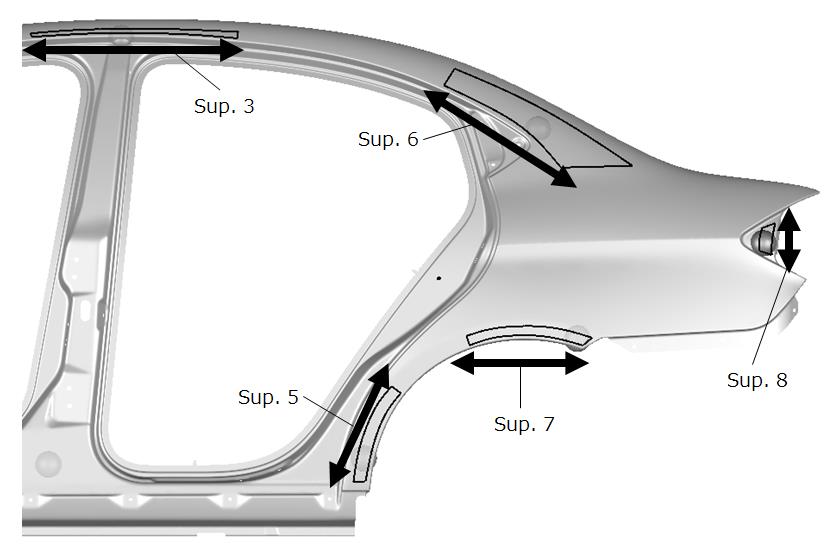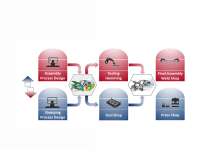An Exchange of Knowledge Between Japanese Toolmakers and the European Approach, Through a Distinctly Australian Lens.
After spending most of his life in Australia, Sam Clough moved to Germany in October 2008. He’s been working as the Social Media Coordinator at AutoForm in Dortmund, Germany for the past three years. It’s easy to become insulated in our world view and work environment, forgetting that things can look totally different from another context. To gain a broader perspective, we asked our resident Aussie about “life and work in Germany” and the lessons he took away from visiting Japan during the launch of the Japanese version of FormingWorld.com. Here he shares what he learned about the Japanese sheet metal forming industry, the mentality behind Japanese process planning and its ironies.
Sam recently travelled to AutoForm’s Japanese office in Tokyo for the launch of the Japanese language version of our blog. The new website JapanForming.com is the first of its kind in Japan and will provide original and translated content from FormingWorld.com to engage our Japanese readers. In turn, JapanForming.com will receive new articles from local Asia-Pacific experts and customers, which we’ll soon feature here in the English language blog.
Driven by his inquisitive nature, Sam used his visit to Japan to absorb some of the local customs and culture. Here’s him reporting his thoughts and impressions:
“I’m an Australian living in Germany; many aspects of life took some getting used to when I first moved to Europe. Naturally, when I arrived in Japan, I had seemingly endless questions about the culture, the people and their mentality. I’ve only been an Australian since my teen years. I was actually born in New Zealand, hailing from the tribal Maori culture. From this perspective, I found that quite a few of the things my Japanese colleagues said felt very familiar to me. Certain characteristics of their body language felt quite the same.
In addition to launching the Japanese blog, I decided to report on my cultural experience as a whole and how the approach to sheet metal forming and digital engineering differs in Japan.
Our European colleagues in the Japanese office also described the distinctions of their working experience in Japan. It really is another world. Not just the local culture; engineering as a whole is tackled with a different approach.
A surprising takeaway for me is that colleagues can have fun together. Once out of the office, the restrictions are thrown aside. Fun and a plethora of food become the focus of after-hours events. You have to be careful or they’ll make you do karaoke – which is exactly what happens after events like the recent Numisheet 2019. Compared to us, our Japanese counterparts sing like popstars! But if you get up there and sound terrible – not to worry! You know you sounded awful and they know it too. Still, everybody will compliment you all the same. Several European colleagues reported having this experience following a karaoke flop.
This behavior clued me in to the first cultural difference; in Japan, they view complimenting as a means of building relationships. In fact, consistently receiving compliments is a good indication that you’re still an outsider. Once you start hearing some criticism and correction, then you know: Aha, now I’m becoming part of the group.
On the other hand, Australians are not helpful in the same way. They won’t compliment you or correct you in the slightest. On the contrary, they’ll ridicule you for fun, actively trying to embarrass you! This is part of our Aussie culture. We enjoy “ripping on” one another and it’s all considered healthy banter. You’re not supposed to get upset or angry in Australia. Your goal is to take it well and dish it back as hard as you get it. That’s all part of the fun. Actually, the more they dish at you, and the more you throw back, the more you’re accepted.

Fig. 1: Hironori Imai’s post on stability analysis for dimensional accuracy was one of several Japanese articles published on FormingWorld.com. Now European tool makers will see their case studies published on JapanForming.com
The first thing I tried to learn about in Japan was the difference in communication styles. I found that reading between the lines is extremely important there. It’s something I’m really not used to. I will often later exclaim, “What? Nobody said that!” In Germany, I’ve heard the expression “Something not said is of course not heard.” Or, to put it another way, when a westerner wants to share ten points, we might explain all ten, plus another five for good measure. But in Japan, I came across the most fascinating expression: “Ichi ieba ju wo shiru,” which means “Hear one, understand ten!” They perhaps think us far too verbose. But, in communicating this way for their entire lives, they are experts at reading between the lines. Whole conversations are going on that I would miss entirely. If you’re not used to it, you might assume they are somehow reading your mind. Interestingly, this perspective has taught me to be careful not to over-crowd my Japanese partners with verbiage. I was told not to “think out loud” or “play devil’s advocate” in Japan. It will send people spinning! To that end, our European colleagues explained how they are learning to think ahead and boil their message down to the most important key points. But I can’t do that. As a “social media person” I’m expected to be the chatterbox. And this is how I gather ideas for interesting blog stories.
Another interesting difference is that compared to westerners, our Japanese counterparts seem initially reserved about sharing information. But they are not withholding anything purposefully; it’s just considered polite to not openly challenge someone’s ideas. Instead, they opt to ask in private. I find this quite refreshing, as it creates a sense of cooperative trust. We are all partners and I witnessed how the Japanese motivate each other by sharing positive opinions. They’ll offer compliments to encourage the team. While Germans can also be quite supportive, they are generally known for being rather blunt and to the point. Here in Germany, I learned another expression from the south: “Nicht geschimpft ist genug gelobt.” This means “Not criticizing is praise enough.” More than just a bit of dark humor, this phrase tells you just how direct Germans can be towards each other.
One advantage of the Japanese work culture is that everyone gets on board together. In Europe and Australia, we all love to imagine that we can steer the ship and create our own projects and sub-projects. We might even become blind to the big picture. The Japanese are not at all like this. They take the perspective of a common decision. There is a communal thinking here, which assumes that every decision should be beneficial for everyone. There is a certain sense of trust in the hierarchy and its ambitions. “It’s got to be good for us, so we agree” is an underlying value. Actually, this is something that really resonates with my Maori culture because our leaders are expected to decide for the whole tribe and great consideration is given to the entire group.
Through interviews with AutoForm staff, I discovered the disadvantages of this perspective too: In this mindset, it’s hard to think outside the box. For example, when it comes to tool tryout, the tryout team isn’t looking for alternatives beyond what was agreed. It’s hard to describe but everyone seems to know they have clearly defined tasks and assignments. And yet, in juxtaposition to this mode of working, job definitions in Japan actually tend to be quite vague! Everyone says your career path can change quite a lot over the course of your life, in ways you did not foresee years before. Now, this very much fits with Australian sensibilities. But in Germany, I’ve observed that a lot of people prefer to stay in the same defined job until they retire.
Strategically, part forming is different in Japan. The stereotype is that Germans are particularly cautious and that everyone has ten insurance policies. In Europe, our customers work towards feasibility in increments, verifying the first forming operations before taking another step further in the design or process plan. In Japan, I found that our customers work quite differently, perhaps due to a lack of this “constantly looking left and right” mentality. By this, I mean nothing negative, as once they decide to work on a part, they go “all in”. That means they’ll work further into a project before performing checks. They might already have 80% of the process outlined in their project before reviewing. This is especially true for process development and surface creation. The layout engineering of our customers in Europe would dedicate two weeks to this phase of work, for example. At this same point, they’d have 40% of the layout done and would still have several alternative paths to take from there. The key point is, the European toolmaker can still make alterations and look for compromises within their tool design. At this early phase in Europe, many discussions will be held even at this unfinished state. In Japan, what I saw was quite different. Because they have stricter guidelines to follow, the first phase of work is twice as long! This translates to greater maturity of the engineering process plan and tool design by the time they reach the first evaluation. Their second phase might see the process engineering go from 80% to 95% complete. At this point, there are less options to find a compromise. In Germany, we review earlier based upon a lower maturity, and we enjoy the added flexibility of that approach. Therefore, part of my aim for JapanForming.com is to share what European OEMs are doing successfully for our customers here. And in return, FormingWorld.com will gain valuable insights from Japan.”
Together, the FormingWorld and JapanForming blogs have the potential to become a global exchange platform for the entire sheet metal forming community. An opportunity to share engineering ideas, process details, and also cultural differences on an international scale.
Of course, setting up the JapanForming.com project came with a few perks. First, I miss Japan already just for the food. It’s nothing like the “Japanese food” we get here in Germany; the true cuisine is far better. Not only because the fish is so fresh, but also for the diversity of flavors and spices. In Australia, we have a large Japanese community and constant access to fresh fish, so the Japanese food back home is actually quite excellent. In Germany, you’ll only see two extras at the table: good old salt and pepper. A Japanese colleague reminded me of this fact during a recent visit he made to Germany, saying “It’s strange over here in Germany. Why do you only put salt on everything? It’s all that’s available. Do Europeans really like just salt and nothing else?” While in Japan, I realized he was right. I struggled to find any additional salt at the table to suit my western taste buds. Actually, I took some Japanese colleagues out to eat in Germany recently. For them, our plain food was already too salty. Our European colleagues, of course, added extra salt.”
To our Japanese team, thanks for the great experience. Our Japanese readers can visit JapanForming.com which will be updated with regular content and translations.













